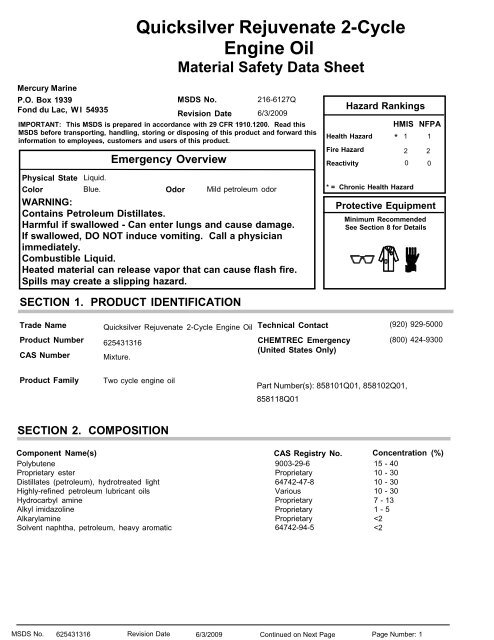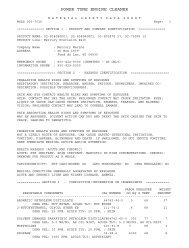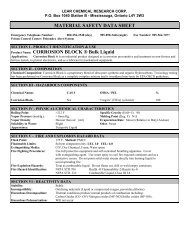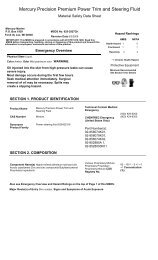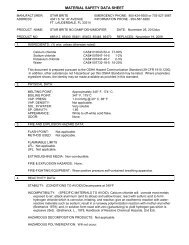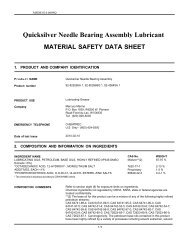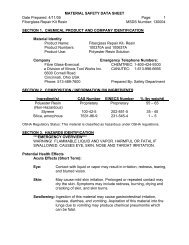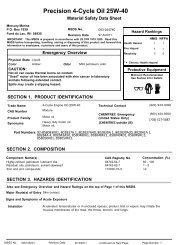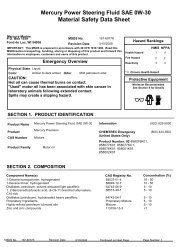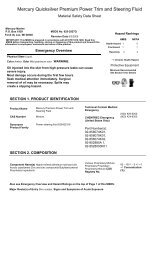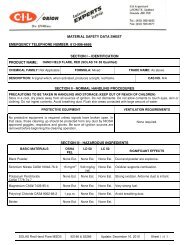Quicksilver Rejuvenate 2-Cycle Engine Oil - Mercury Marine
Quicksilver Rejuvenate 2-Cycle Engine Oil - Mercury Marine
Quicksilver Rejuvenate 2-Cycle Engine Oil - Mercury Marine
You also want an ePaper? Increase the reach of your titles
YUMPU automatically turns print PDFs into web optimized ePapers that Google loves.
<strong>Quicksilver</strong> <strong>Rejuvenate</strong> 2-<strong>Cycle</strong><br />
<strong>Engine</strong> <strong>Oil</strong><br />
Material Safety Data Sheet<br />
<strong>Mercury</strong> <strong>Marine</strong><br />
P.O. Box 1939<br />
Fond du Lac, W I 54935<br />
MSDS No.<br />
Revision Date<br />
216-6127Q<br />
6/3/2009<br />
IMPORTANT: This MSDS is prepared in accordance with 29 CFR 1910.1200. Read this<br />
MSDS before transporting, handling, storing or disposing of this product and forward this<br />
information to employees, customers and users of this product.<br />
Emergency Overview<br />
Physical State Liquid.<br />
Color Blue. Odor Mild petroleum odor<br />
WARNING:<br />
Contains Petroleum Distillates.<br />
Harmful if swallowed - Can enter lungs and cause damage.<br />
If swallowed, DO NOT induce vomiting. Call a physician<br />
immediately.<br />
Combustible Liquid.<br />
Heated material can release vapor that can cause flash fire.<br />
Spills may create a slipping hazard.<br />
Hazard Rankings<br />
HMIS NFPA<br />
Health Hazard * 1 1<br />
Fire Hazard 2 2<br />
Reactivity 0 0<br />
* = Chronic Health Hazard<br />
Protective Equipment<br />
Minimum Recommended<br />
See Section 8 for Details<br />
SECTION 1. PRODUCT IDENTIFICATION<br />
Trade Name<br />
<strong>Quicksilver</strong> <strong>Rejuvenate</strong> 2-<strong>Cycle</strong> <strong>Engine</strong> <strong>Oil</strong><br />
Technical Contact<br />
(920) 929-5000<br />
Product Number<br />
CAS Number<br />
625431316<br />
Mixture.<br />
CHEMTREC Emergency<br />
(United States Only)<br />
(800) 424-9300<br />
Product Family<br />
Two cycle engine oil<br />
Part Number(s): 858101Q01, 858102Q01,<br />
858118Q01<br />
SECTION 2. COMPOSITION<br />
Component Name(s)<br />
Polybutene<br />
Proprietary ester<br />
Distillates (petroleum), hydrotreated light<br />
Highly-refined petroleum lubricant oils<br />
Hydrocarbyl amine<br />
Alkyl imidazoline<br />
Alkarylamine<br />
Solvent naphtha, petroleum, heavy aromatic<br />
CAS Registry No.<br />
9003-29-6<br />
Proprietary<br />
64742-47-8<br />
Various<br />
Proprietary<br />
Proprietary<br />
Proprietary<br />
64742-94-5<br />
Concentration (%)<br />
15 - 40<br />
10 - 30<br />
10 - 30<br />
10 - 30<br />
7 - 13<br />
1 - 5<br />
<strong>Mercury</strong> <strong>Rejuvenate</strong> 2-<strong>Cycle</strong> <strong>Engine</strong> <strong>Oil</strong><br />
SECTION 3. HAZARDS IDENTIFICATION<br />
Also see Emergency Overview and Hazard Ratings on the top of Page 1 of this MSDS.<br />
Major Route(s) of Entry Skin contact. Eye contact. Inhalation.<br />
Signs and Symptoms of Acute Exposure<br />
Inhalation<br />
Eye Contact<br />
Skin Contact<br />
Ingestion<br />
Chronic Health Effects<br />
Summary<br />
Conditions Aggravated<br />
by Exposure<br />
Target Organs<br />
Carcinogenic Potential<br />
At elevated temperatures or in enclosed spaces, product mist or vapors may irritate the<br />
mucous membranes of the nose, the throat, bronchi, and lungs.<br />
This product can cause transient mild eye irritation with short-term contact with liquid sprays<br />
or mists. Symptoms include stinging, watering, redness, and swelling.<br />
This product can cause mild, transient skin irritation. The severity of irritation will depend on<br />
the amount of material that is applied to the skin and the speed and thoroughness that it is<br />
removed. Symptoms include redness, itching, and burning of the skin. Repeated or<br />
prolonged skin contact can produce moderate irritation (dermatitis).<br />
If swallowed, large volumes of material can cause generalized depression, headache,<br />
drowsiness, nausea, vomiting and diarrhea. Smaller doses can cause a laxative effect. If<br />
aspirated into the lungs, liquid can cause lung damage.<br />
Prolonged and/or repeated skin contact may cause irritation and inflamation. Symptoms<br />
include defatting, redness, dryness, blistering eczema-like lesions, scaly dermatitis, and/or<br />
more serious skin disorders. Chronic effects of ingestion and subsequent aspiration into the<br />
lungs may cause pneumatocele (lung cavity) formation and chronic lung dysfunction.<br />
Disorders of the following organs or organ systems that may be aggravated by significant<br />
exposure to this material or its components include: Skin, Respiratory System, Liver,<br />
Kidneys, Central Nervous System (CNS)<br />
May cause damage to the following organs: kidneys, liver, upper respiratory tract, skin,<br />
central nervous system (CNS), eye, lens or cornea<br />
This product is not known to contain any components at concentrations above 0.1% which<br />
are considered carcinogenic by OSHA, IARC or NTP.<br />
OSHA Hazard Classification is indicated by an "X" in the box adjacent to the hazard title. If no "X" is present,<br />
the product does not exhibit the hazard as defined in the OSHA Hazard Communication Standard (29 CFR<br />
1910.1200).<br />
OSHA Health Hazard Classification<br />
OSHA Physical Hazard Classification<br />
Irritant<br />
Toxic<br />
Corrosive<br />
Sensitizer<br />
Highly Toxic<br />
Carcinogenic<br />
Combustible X Explosive Pyrophoric<br />
Flammable Oxidizer Water-reactive<br />
Compressed Gas Organic Peroxide Unstable<br />
SECTION 4. FIRST AID MEASURES<br />
Take proper precautions to ensure your own health and safety before attempting rescue or providing first aid.<br />
For more specific information, refer to Exposure Controls and Personal Protection in Section 8 of this MSDS.<br />
Inhalation Move victim to fresh air. If victim is not breathing, immediately begin rescue breathing. If<br />
breathing is difficult, 100 percent humidified oxygen should be administered by a qualified<br />
individual. Seek medical attention immediately. Keep the affected individual warm and at<br />
rest.<br />
Eye Contact<br />
Check for and remove contact lenses. Flush eyes with cool, clean, low-pressure water while<br />
occasionally lifting and lowering eyelids. Seek medical attention if excessive tearing, redness,<br />
or pain persists.<br />
MSDS No. 625431316 Revision Date 6/3/2009 Continued on Next Page Page Number: 2
<strong>Mercury</strong> <strong>Rejuvenate</strong> 2-<strong>Cycle</strong> <strong>Engine</strong> <strong>Oil</strong><br />
Skin Contact<br />
Ingestion<br />
Notes to Physician<br />
If burned by hot material, cool skin by quenching with large amounts of cool water. For<br />
contact with product at ambient temperatures, remove contaminated shoes and clothing.<br />
Wipe off excess material. Wash exposed skin with mild soap and water. Seek medical<br />
attention if tissue appears damaged or if pain or irritation persists. Thoroughly clean<br />
contaminated clothing before reuse. Clean or discard contaminated leather goods. If material<br />
is injected under the skin, seek medical attention immediately.<br />
Do not induce vomiting unless directed to by a physician. Do not give anything to drink unless<br />
directed to by a physician. Never give anything by mouth to a person who is not fully<br />
conscious. If significant amounts are swallowed or irritation or discomfort occurs, seek<br />
medical attention immediately.<br />
INGESTION: The viscosity range of the product(s) represented by this MSDS is greater than<br />
100 SUS at 100°F. Careful gastric lavage may be considered to evacuate large quantities of<br />
material.<br />
SECTION 5. FIRE FIGHTING MEASURES<br />
NFPA Flammability<br />
Classification<br />
Flash Point<br />
NFPA Class-IIIA combustible liquid.<br />
Closed cup: 80°C (176°F). (Pensky-Martens.)<br />
Open cup: 90°C (194°F) (Cleveland.).<br />
Lower Flammable Limit<br />
Autoignition<br />
Temperature<br />
Hazardous Combustion<br />
Products<br />
Special Properties<br />
Extinguishing Media<br />
Protection of Fire<br />
Fighters<br />
No data.<br />
Not available.<br />
Upper Flammable Limit<br />
No data.<br />
Carbon dioxide, carbon monoxide, smoke, fumes, unburned hydrocarbons and oxides of<br />
sulfur and/or nitrogen.<br />
This material will release vapors when heated above the flash point temperature that can<br />
ignite when exposed to a source of ignition. In enclosed spaces, vapors can ignite with<br />
explosive force. Mists or sprays may burn at temperatures below the flash point.<br />
SMALL FIRE: Use dry chemicals, carbon dioxide, foam, or inert gas (nitrogen). Carbon<br />
dioxide and inert gas can displace oxygen. Use caution when applying carbon dioxide or<br />
inert gas in confined spaces.<br />
LARGE FIRE: Use foam, water fog, or water spray. Water fog and spray are effective in<br />
cooling containers and adjacent structures. However, water can cause frothing and/or may<br />
not extinguish the fire. Water can be used to cool the external walls of vessels to prevent<br />
excessive pressure, autoignition or explosion. DO NOT use a solid stream of water directly<br />
on the fire as the water may spread the fire to a larger area.<br />
Firefighters must use full bunker gear including NIOSH-approved positive pressure<br />
self-contained breathing apparatus to protect against potential hazardous combustion or<br />
decomposition products and oxygen deficiencies. Withdraw immediately from the area if<br />
there is a rising sound from a venting safety device or discoloration of vessels, tanks, or<br />
pipelines.<br />
SECTION 6. ACCIDENTAL RELEASE MEASURES<br />
Take proper precautions to ensure your own health and safety before attempting spill control or clean-up. For more<br />
specific information, refer to the Emergency Overview on Page 1, Exposure Controls and Personal Protection in<br />
Section 8 and Disposal Considerations in Section 13 of this MSDS.<br />
Do not touch damaged containers or spilled material unless wearing appropriate protective<br />
equipment. Slipping hazard; do not walk through spilled material. Stop leak if you can do so<br />
without risk. For small spills, absorb or cover with dry earth, sand, or other inert<br />
non-combustible absorbent material and place into waste containers for later disposal. Contain<br />
large spills to maximize product recovery or disposal. Prevent entry into waterways or sewers.<br />
In urban area, cleanup spill as soon as possible. In natural environments, seek cleanup advice<br />
from specialists to minimize physical habitat damage. This material will float on water.<br />
Absorbent pads and similar materials can be used. Comply with all laws and regulations<br />
MSDS No. 625431316 Revision Date 6/3/2009 Continued on Next Page Page Number: 3
<strong>Mercury</strong> <strong>Rejuvenate</strong> 2-<strong>Cycle</strong> <strong>Engine</strong> <strong>Oil</strong><br />
SECTION 7. HANDLING AND STORAGE<br />
Handling<br />
A spill or leak can cause an immediate fire or explosion hazard. Keep containers closed and<br />
do not handle or store near heat, sparks, or any other potential ignition sources. Avoid<br />
contact with oxidizing agents. Do not breathe vapor. Use only with adequate ventilation and<br />
personal protection. Never siphon by mouth. Avoid contact with eyes, skin, and clothing.<br />
Prevent contact with food and tobacco products. Do not take internally.<br />
When performing repairs and maintenance on contaminated equipment, keep unnecessary<br />
persons away from the area. Eliminate all potential ignition sources. Drain and purge<br />
equipment, as necessary, to remove material residues. Follow proper entry procedures,<br />
including compliance with 29 CFR 1910.146 prior to entering confined spaces such as tanks<br />
or pits. Use gloves constructed of impervious materials and protective clothing if direct<br />
contact is anticipated. Provide ventilation to maintain exposure potential below applicable<br />
exposure limits. Use appropriate respiratory protection when concentrations exceed any<br />
established occupational exposure level (See Section 8). Promptly remove contaminated<br />
clothing. Wash exposed skin thoroughly with soap and water after handling.<br />
Non equilibrium conditions may increase the fire hazard associated with this product. Always<br />
bond receiving containers to the fill pipe before and during loading. Always confirm that<br />
receiving container is properly grounded. Bonding and grounding alone may be inadequate to<br />
eliminate fire and explosion hazards. Carefully review operations that may increase the risks<br />
such as tank and container filling, tank cleaning, sampling, gauging, loading, filtering, mixing,<br />
agitation, etc. In addition to bonding and grounding, efforts to mitigate the hazards may<br />
include, but are not limited to, ventilation, inerting and/or reduction of transfer velocities.<br />
Always keep nozzle in contact with the container throughout the loading process. Do NOT fill<br />
any portable container in or on a vehicle. Do NOT use compressed air for filling, discharging<br />
or other handling operations.<br />
Storage<br />
Product container is not designed for elevated pressure. Do not pressurize, cut, weld, braze<br />
solder, drill, or grind on containers. Do not expose product containers to flames, sparks, heat<br />
or other potential ignition sources. Empty containers may contain product residues that can<br />
ignite with explosive force. Observe label precautions. Consult appropriate federal, state and<br />
local authorities before reusing, reconditioning, reclaiming, recycling or disposing of empty<br />
containers and/or waste residues of this product.<br />
Keep container tightly closed. Store in a cool, dry, well-ventilated area. Store only in<br />
approved containers. Do not store with oxidizing agents. Do not store at elevated<br />
temperatures or in direct sunlight. Protect containers against physical damage. Head space<br />
in tanks and other containers may containers may contain vapor in the flammable range.<br />
Vapor may be ignited by static discharge. Storage area must meet OSHA requirements and<br />
applicable fire codes.<br />
Additional information regarding the design and control of hazards associated with the<br />
handling and storage of flammable and combustible liquids may be found in professional and<br />
industrial documents including, but not limited to, the National Fire Protection Association<br />
(NFPA) publications NFPA 30 ("Flammable and Combustible Liquid Code"), NFPA 77<br />
("Recommended Practice on Static Electricity") and the American Petroleum Institute (API)<br />
Recommended Practice 2003, “Protection Against Ignitions Arising Out of Static, Lightning,<br />
and Stray Currents' (liquids)."<br />
SECTION 8. EXPOSURE CONTROLS AND PERSONAL PROTECTION<br />
<strong>Engine</strong>ering Controls<br />
Provide exhaust ventilation or other engineering controls to keep the airborne concentrations<br />
of mists and/or vapors below the recommended exposure limits (see below). An eye wash<br />
station and safety shower should be located near the work-station.<br />
MSDS No. 625431316 Revision Date 6/3/2009 Continued on Next Page Page Number: 4
<strong>Mercury</strong> <strong>Rejuvenate</strong> 2-<strong>Cycle</strong> <strong>Engine</strong> <strong>Oil</strong><br />
Personal Protective<br />
Equipment<br />
Personal protective equipment should be selected based upon the conditions under which<br />
this material is used. A hazard assessment of the work area for PPE requirements should<br />
be conducted by a qualified professional pursuant to OSHA regulations. The following<br />
pictograms represent the minimum requirements for personal protective equipment. For<br />
certain operations, additional PPE may be required.<br />
Eye Protection<br />
Hand Protection<br />
Body Protection<br />
Respiratory Protection<br />
General Comments<br />
Occupational Exposure Guidelines<br />
Safety glasses equipped with side shields are recommended as minimum protection in<br />
industrial settings. Wear goggles if splashing or spraying is anticipated. Wear goggles and<br />
face shield if material is heated above 125°F (51°C). Have suitable eye wash water<br />
available.<br />
Avoid skin contact. Use heavy duty gloves constructed of chemical resistant materials such<br />
as Viton® or heavy nitrile rubber. Wash hands with plenty of mild soap and water before<br />
eating, drinking, smoking, use of toilet facilities or leaving work. DO NOT use gasoline,<br />
kerosene, solvents or harsh abrasives as skin cleaners.<br />
Use clean protective clothing if splashing or spraying conditions are present. Protective<br />
clothing may include long-sleeve outer garment, apron, or lab coat. If significant contact<br />
occurs, remove oil-contaminated clothing as soon as possible and promptly shower.<br />
Launder contaminated clothing before reuse or discard. Wear heat protective boots and<br />
protective clothing when handling material at elevated temperatures.<br />
The need for respiratory protection is not anticipated under normal use conditions and with<br />
adequate ventilation. If elevated airborne concentrations above applicable workplace<br />
exposure levels are anticipated, a NIOSH-approved organic vapor respirator equipped with a<br />
dust/mist prefilter should be used. Protection factors vary depending upon the type of<br />
respirator used. Respirators should be used in accordance with OSHA requirements (29<br />
CFR 1910.134).<br />
Use good personal hygiene practices. Wash hands and other exposed skin areas with<br />
plenty of mild soap and water before eating, drinking, smoking, use of toilet facilities, or<br />
leaving work. DO NOT use gasoline, kerosene, solvents or harsh abrasives as skin<br />
cleaners. Since specific exposure standards/control limits have not been established for this<br />
product, the "<strong>Oil</strong> Mist, Mineral" exposure limits shown below are suggested as minimum<br />
control guidelines.<br />
Substance<br />
<strong>Oil</strong> Mist, Mineral<br />
Distillates (petroleum), hydrotreated light<br />
Applicable Workplace Exposure Levels<br />
ACGIH (United States). TWA:<br />
5 mg/m 3 8 hour(s). STEL: 10<br />
mg/m 3 15 minute(s).<br />
OSHA (United States). TWA:<br />
5 mg/m 3 8 hour(s). ACGIH<br />
TLV (United States).<br />
TWA: 100 ppm 8 hour(s).<br />
OSHA PEL (United States).<br />
TWA: 500 ppm 8 hour(s).<br />
SECTION 9. PHYSICAL AND CHEMICAL PROPERTIES (TYPICAL)<br />
Physical State<br />
Liquid.<br />
Color<br />
Blue.<br />
Odor<br />
Mild petroleum odor<br />
Specific Gravity<br />
0.88 (Water = 1)<br />
pH<br />
Not applicable<br />
Vapor<br />
Density<br />
>1 (Air = 1)<br />
Boiling Range<br />
Not available.<br />
Melting/Freezing<br />
Point<br />
Not available.<br />
Volatility<br />
MSDS No. 625431316 Revision Date 6/3/2009 Continued on Next Page Page Number: 5
Vapor Pressure<br />
<strong>Mercury</strong> <strong>Rejuvenate</strong> 2-<strong>Cycle</strong> <strong>Engine</strong> <strong>Oil</strong><br />
2000 mg/kg [Rabbit].<br />
Studies on laboratory animals have associated similar materials with eye and respiratory tract<br />
irritation. Repeated exposure to elevated concentrations of hydrocarbon solvents can<br />
produce a variety of transient CNS effects (e.g., dizziness, headache, narcosis, etc). Studies<br />
on laboratory animals have shown similar materials to cause skin irritation after repeated or<br />
prolonged contact. Repeated direct application of similar materials to the skin can produce<br />
defatting dermatitis and kidney damage in laboratory animals. The most common effects<br />
observed in repeated dose animal studies with mineral spirits are kidney changes that are<br />
consistent with an alpha 2u-globulin- mediated process that is not regarded as relevant to<br />
humans. Certain studies have reported effects in the liver as well as hematological or urine<br />
chemistry changes. In general, these effects have not to been shown to be dose-related.<br />
Highly-refined petroleum lubricant oil:s<br />
ORAL (LD50): Acute: >5000 mg/kg [Rat].<br />
DERMAL (LD50): Acute: >2000 mg/kg [Rabbit].<br />
Mineral oil mists derived from highly refined oils are reported to have low acute and sub-acute<br />
toxicities in animals. Effects from single and short-term repeated exposures to high<br />
concentrations of mineral oil mists well above applicable workplace exposure levels include<br />
lung inflammatory reaction, lipoid granuloma formation and lipoid pneumonia. In acute and<br />
sub-acute studies involving exposures to lower concentrations of mineral oil mists at or near<br />
current work place exposure levels produced no significant toxicological effects. In long term<br />
studies (up to two years) no carcinogenic effects have been reported in any animal species<br />
tested.<br />
MSDS No. 625431316 Revision Date 6/3/2009 Continued on Next Page Page Number: 6
<strong>Mercury</strong> <strong>Rejuvenate</strong> 2-<strong>Cycle</strong> <strong>Engine</strong> <strong>Oil</strong><br />
SECTION 12. ECOLOGICAL INFORMATION<br />
Ecotoxicity<br />
Environmental Fate<br />
Analysis for ecological effects has not been conducted on this product. However, if spilled,<br />
this product and any contaminated soil or water may be harmful to human, animal, and<br />
aquatic life. Also, the coating action associated with petroleum and petroleum products can<br />
be harmful or fatal to aquatic life and waterfowl.<br />
An environmental fate analysis is not available for this specific product. Plants and animals<br />
may experience harmful or fatal effects when coated with petroleum products.<br />
Petroleum-based (mineral) lubricating oils normally will float on water. In stagnant or<br />
slow-flowing waterways, an oil layer can cover a large surface area. As a result, this oil layer<br />
might limit or eliminate natural atmospheric oxygen transport into the water. With time, if not<br />
removed, oxygen depletion in the waterway may be sufficient to cause a fish kill or create an<br />
anaerobic environment.<br />
SECTION 13. DISPOSAL CONSIDERATIONS<br />
Hazard characteristic and regulatory waste stream classification can change with product use. Accordingly, it is<br />
the responsibility of the user to determine the proper storage, transportation, treatment and/or disposal<br />
methodologies for spent materials and residues at the time of disposition.<br />
Conditions of use may cause this material to become a "hazardous waste", as defined by<br />
federal or state regulations. It is the responsibility of the user to determine if the material is a<br />
"hazardous waste" at the time of disposal. Transportation, treatment, storage, and disposal<br />
of waste material must be conducted in accordance with RCRA regulations (see 40 CFR 260<br />
through 40 CFR 271). State and/or local regulations may be more restrictive. Contact your<br />
regional US EPA office for guidance concerning case specific disposal issues. Empty drums<br />
and pails retain residue. DO NOT pressurize, cut, weld, braze, solder, drill, grind, or expose<br />
this product's empty container to heat, flame, or other ignition sources. DO NOT attempt to<br />
clean it. Empty drums and pails should be drained completely, properly bunged or sealed,<br />
and promptly sent to a reconditioner.<br />
SECTION 14. TRANSPORT INFORMATION<br />
The shipping description below may not represent requirements for all modes of transportation, shipping<br />
methods or locations outside of the United States.<br />
US DOT Status<br />
Proper Shipping Name<br />
Hazard Class<br />
Reportable Quantity<br />
Placard(s)<br />
A U.S. Department of Transportation regulated material.<br />
UN1268, Petroleum Distillates, n.o.s., Combustible Liquid<br />
[This product has a flash point temperature between 60.5° to 93°C (141° and 200°F). Bulk<br />
shipments of this product are regulated.]<br />
Combustible liquid.<br />
Packing Group<br />
UN/NA Number<br />
A Reportable Quantity (RQ) has not been established for this material.<br />
Emergency Response<br />
Guide No.<br />
MARPOL III Status<br />
Combustible liquid.<br />
UN1268<br />
Not applicable.<br />
Not a DOT "<strong>Marine</strong><br />
Pollutant" per 49 CFR<br />
171.8.<br />
MSDS No. 625431316 Revision Date 6/3/2009 Continued on Next Page Page Number: 7
<strong>Mercury</strong> <strong>Rejuvenate</strong> 2-<strong>Cycle</strong> <strong>Engine</strong> <strong>Oil</strong><br />
SECTION 15. REGULATORY INFORMATION<br />
<strong>Oil</strong>: The product(s) represented by this MSDS is (are)<br />
regulated as “oil” under 49 CFR Part 130. Shipments by<br />
rail or highway in packaging having a capacity of 3500<br />
gallons or more or in a quantity greater 42,000 gallons<br />
are subject to these requirements. In addition, mixtures<br />
containing 10% or more of this product may be subject to<br />
these requirements.<br />
TSCA Inventory<br />
SARA 302/304<br />
Emergency Planning<br />
and Notification<br />
SARA 311/312 Hazard<br />
Identification<br />
SARA 313 Toxic<br />
Chemical Notification<br />
and Release Reporting<br />
CERCLA<br />
Clean Water Act<br />
(CWA)<br />
California<br />
Proposition 65<br />
New Jersey<br />
Right-to-Know Label<br />
Additional Remarks<br />
This product and/or its components are listed on the Toxic Substances Control Act (TSCA)<br />
inventory.<br />
The Superfund Amendments and Reauthorization Act of 1986 (SARA) Title III requires<br />
facilities subject to Subparts 302 and 304 to submit emergency planning and notification<br />
information based on Threshold Planning Quantities (TPQs) and Reportable Quantities<br />
(RQs) for "Extremely Hazardous Substances" listed in 40 CFR 302.4 and 40 CFR 355. No<br />
components were identified.<br />
The Superfund Amendments and Reauthorization Act of 1986 (SARA) Title III requires<br />
facilities subject to this subpart to submit aggregate information on chemicals by "Hazard<br />
Category" as defined in 40 CFR 370.2. This material would be classified under the following<br />
hazard categories:<br />
Fire, Acute (Immediate) Health Hazard, Chronic (Delayed) Health Hazard<br />
This product contains the following components in concentrations above de minimis levels<br />
that are listed as toxic chemicals in 40 CFR Part 372 pursuant to the requirements of Section<br />
313 of SARA: No components were identified.<br />
The Comprehensive Environmental Response, Compensation, and Liability Act of 1980<br />
(CERCLA) requires notification of the National Response Center concerning release of<br />
quantities of "hazardous substances" equal to or greater than the reportable quantities (RQ's)<br />
listed in 40 CFR 302.4. As defined by CERCLA, the term "hazardous substance" does not<br />
include petroleum, including crude oil or any fraction thereof which is not otherwise<br />
specifically designated in 40 CFR 302.4. Chemical substances present in this product or<br />
refinery stream that may be subject to this statute are:<br />
Naphthalene [CAS No.: 91-20-3] RQ = 100 lbs. (45.36 kg) Concentration:
<strong>Mercury</strong> <strong>Rejuvenate</strong> 2-<strong>Cycle</strong> <strong>Engine</strong> <strong>Oil</strong><br />
SECTION 16. OTHER INFORMATION<br />
Refer to the top of Page 1 for the HMIS and NFPA Hazard Ratings for this product.<br />
REVISION INFORMATION<br />
Version Number 1.00<br />
Revision Date<br />
6/3/2009<br />
ABBREVIATIONS<br />
AP: Approximately<br />
NA: Not Applicable<br />
EQ: Equal<br />
ND: No Data<br />
ACGIH: American Conference of Governmental Industrial Hygienists<br />
AIHA: American Industrial Hygiene Association<br />
IARC: International Agency for Research on Cancer<br />
NIOSH: National Institute of Occupational Safety and Health<br />
NPCA: National Paint and Coating Manufacturers Association<br />
EPA: US Environmental Protection Agency<br />
HMIS: Hazardous Materials Information System<br />
OSHA: Occupational Safety and Health Administration<br />
NTP: National Toxicology Program<br />
NFPA: National Fire Protection Association<br />
>: Greater Than<br />
NE: Not Established<br />


